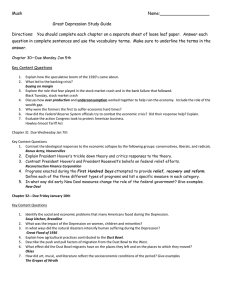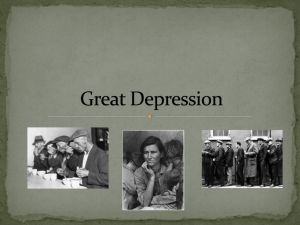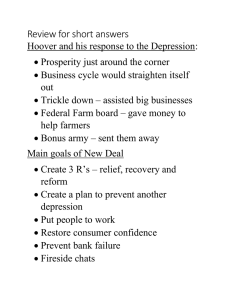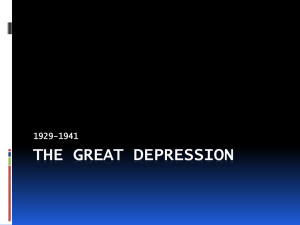Topic 3/4: Great Depression/New Deal Name: _________________________ Block: ____ Date:____________
advertisement
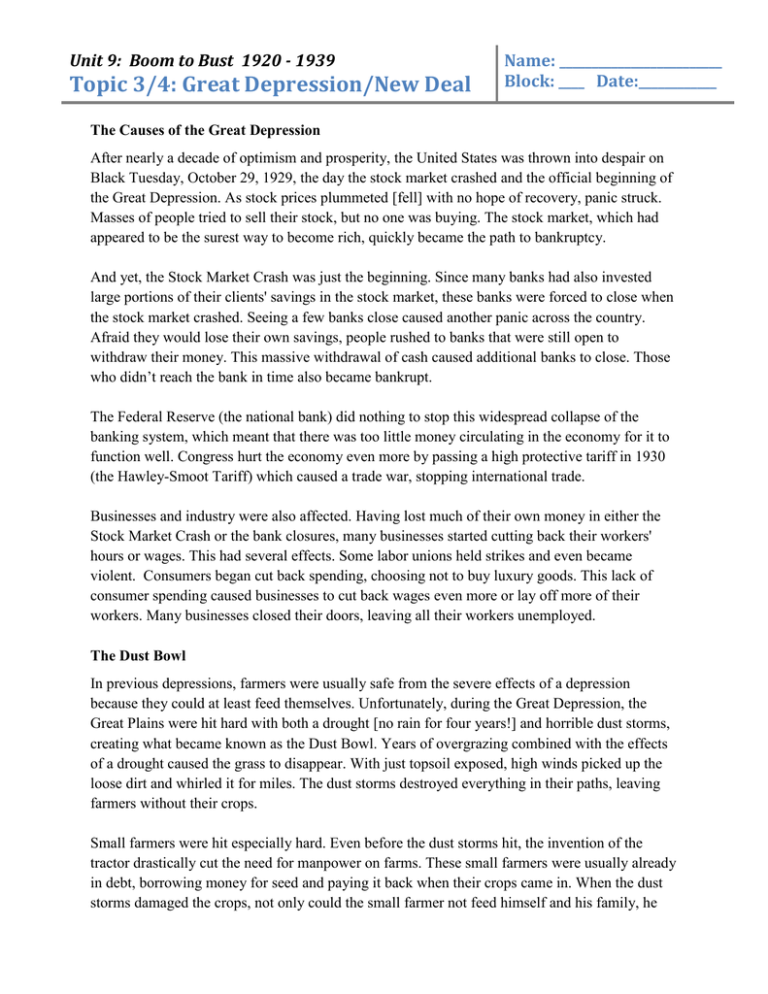
Unit 9: Boom to Bust 1920 - 1939 Topic 3/4: Great Depression/New Deal Name: _________________________ Block: ____ Date:____________ The Causes of the Great Depression After nearly a decade of optimism and prosperity, the United States was thrown into despair on Black Tuesday, October 29, 1929, the day the stock market crashed and the official beginning of the Great Depression. As stock prices plummeted [fell] with no hope of recovery, panic struck. Masses of people tried to sell their stock, but no one was buying. The stock market, which had appeared to be the surest way to become rich, quickly became the path to bankruptcy. And yet, the Stock Market Crash was just the beginning. Since many banks had also invested large portions of their clients' savings in the stock market, these banks were forced to close when the stock market crashed. Seeing a few banks close caused another panic across the country. Afraid they would lose their own savings, people rushed to banks that were still open to withdraw their money. This massive withdrawal of cash caused additional banks to close. Those who didn’t reach the bank in time also became bankrupt. The Federal Reserve (the national bank) did nothing to stop this widespread collapse of the banking system, which meant that there was too little money circulating in the economy for it to function well. Congress hurt the economy even more by passing a high protective tariff in 1930 (the Hawley-Smoot Tariff) which caused a trade war, stopping international trade. Businesses and industry were also affected. Having lost much of their own money in either the Stock Market Crash or the bank closures, many businesses started cutting back their workers' hours or wages. This had several effects. Some labor unions held strikes and even became violent. Consumers began cut back spending, choosing not to buy luxury goods. This lack of consumer spending caused businesses to cut back wages even more or lay off more of their workers. Many businesses closed their doors, leaving all their workers unemployed. The Dust Bowl In previous depressions, farmers were usually safe from the severe effects of a depression because they could at least feed themselves. Unfortunately, during the Great Depression, the Great Plains were hit hard with both a drought [no rain for four years!] and horrible dust storms, creating what became known as the Dust Bowl. Years of overgrazing combined with the effects of a drought caused the grass to disappear. With just topsoil exposed, high winds picked up the loose dirt and whirled it for miles. The dust storms destroyed everything in their paths, leaving farmers without their crops. Small farmers were hit especially hard. Even before the dust storms hit, the invention of the tractor drastically cut the need for manpower on farms. These small farmers were usually already in debt, borrowing money for seed and paying it back when their crops came in. When the dust storms damaged the crops, not only could the small farmer not feed himself and his family, he could not pay back his debt. Banks would then foreclose on the small farms and the farmer's family would be both homeless and unemployed. Riding the Rails During the Great Depression, millions of people were out of work. Many people hit the road, traveling from place to place, hoping to find a job. A few had cars, but most hitchhiked or "rode the rails." Teens, men, women, and entire families traveled this way. They would board freight trains and crisscross the country. When there was an opening, there might be a thousand people applying for the same job. Those who weren't lucky enough to get the job might stay in a shantytown (called "Hoovervilles") outside of town. Housing in the shantytown was built out of any material that could be found, like driftwood, cardboard, or even newspapers. The farmers who had lost their homes and land usually headed west to California, where they heard rumors of farm jobs. Unfortunately, although there was some work, the conditions for these families were temporary and hostile. Since many of the farmers came from Oklahoma and Arkansas, they were called the names like "Okies" and "Arkies." Roosevelt and the New Deal The U.S. economy broke down and entered the Great Depression during the presidency of Herbert Hoover. Although President Hoover repeatedly spoke of optimism, the people blamed him for the Great Depression. Just as the shantytowns were named Hoovervilles after him, newspapers became known as "Hoover blankets," pockets of pants turned inside out (to show they were empty) were called "Hoover flags," and broken-down cars pulled by horses were known as "Hoover wagons." During the 1932 presidential election, Hoover did not stand a chance at reelection and Franklin D. Roosevelt won in a landslide. People had high hopes that President Roosevelt would be able to solve all their troubles. As soon as Roosevelt took office, he closed all the banks for a week and only let them reopen once they were stabilized. Roosevelt began to establish programs for Relief, Recovery, and Reform that became known as the New Deal. These New Deal programs were most commonly known by their initials, which reminded some people of alphabet soup. The first group of programs brought relief to the unemployed by providing jobs and incomes and hiring people for various projects, like the CCC (Civilian Conservation Corps) and the WPA (Works Progress Administration). Another group of recovery programs helped to bring parts of the economy out of the depression over time, like the AAA (Agricultural Adjustment Act). The last group of programs put reforms in place to correct bad banking and investment practices. These included FDIC (Federal Deposit Insurance Corp) and the SEC (Securities and Exchange Commission) to prevent bank failures and to regulate the stock market. The Social Security program we still have today was also created during the New Deal to provide an income for people who cannot work because they are elderly or disabled.
